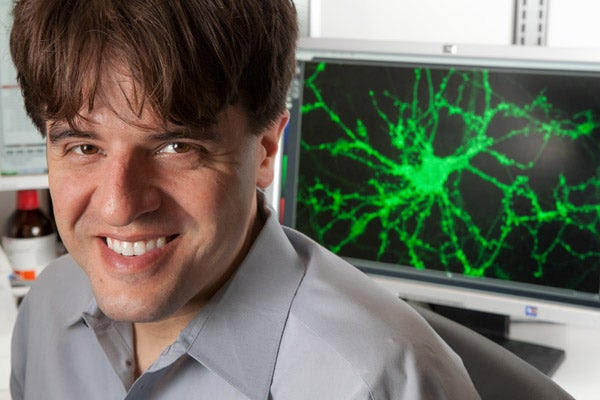This protein responds to light in a manner that is related to how neurons fire — it forms a channel on the cell surface that opens and allows ions into the cell. In the nerve, that channel opens when it receives a signal to fire. In the algae, it opens in response to light. If channelrhodopsin could be made to do the same thing in a neuron of a living animal it might provide a way of controlling the activity of that neuron using light — perhaps even during animal behaviors.
The concept seemed theoretically possible but risky, and indeed getting it to work in living animals took many years. Delivering the required large number of opsins into specific groups of cells within the brain, and targeting light deep into the brain, both posed challenges, and many opsins were initially not well-produced or tolerated by neurons.
When all the key pieces finally fell into place, they were able to use fiber optics to shine a tiny light onto a group of neurons harboring opsins in living animals and cause just that specific subset of neurons to either fire or be silenced in ways that controlled normal or disease-related behaviors.
"Karl had the insight to realize how important this was going to be," says Malenka, who is also the Nancy Friend Pritzker professor. "The idea had been floating around but he recognized the importance of the channelrhodopsin discovery and made it work."
Helping patients
Deisseroth believes the most important contribution from optogenetics will be its role in understanding biology and behavior, but says it will also likely contribute to medical advances.
Karl Deisseroth, professor of bioengineering and of psychiatry and behavioral science, has been awarded the 2014 Keio Medical Science Prize for his groundbreaking work in optogenetics. (Photo: Saul Bromberger and Sandra Hoover)
One example of how optogenetics could point to better therapies came from work in Parkinson's disease. Deisseroth and his team used optogenetics to stimulate different components of the brain's wiring in animals with a version of Parkinson's disease, and found that connections arriving into a particular region deep in the brain, when stimulated, powerfully reduce symptoms.
Doctors who treat Parkinson's disease will sometimes implant an electrode that stimulates this brain region in patients, with quite a bit of success in reducing symptoms. But there had been debate over what wiring the electrode should stimulate. Deisseroth's work pointed to these arriving neuronal connections.
"Now neurosurgeons are finding that placing their electrical contacts to target connections gives better results in treating symptoms in people with Parkinson's and many other conditions," Deisseroth said.
Pond scum to the rescue?
Decades ago, when teams of scientists began studying the light-sensitive proteins within microbes it wasn't with an eye toward one day helping people with depression, Parkinson's disease or untreatable pain.
It was to better understand the intricate and amazing world around us. The research was fueled by pure scientific curiosity. Curiosity that has, as it happens, led to a discovery that might just help people.
Deisseroth argued in a Scientific American piece about the importance of funding curiosity-driven research as opposed to more targeted disease-focus research that some scientists and funding agencies have advocated.
"The more directed and targeted research becomes, the more likely we are to slow our progress, and the more certain it is that the distant and untraveled realms, where truly disruptive ideas can arise, will be utterly cut off from our common scientific journey," Deisseroth wrote.
He argues that funding agencies need to not only support fundamental research, but also facilitate the translation of that basic research into the work that can one day help patients.
"This is something that Bio-X does well," Deisseroth said. He works in the Clark Center that houses Bio-X, where scientists from very different backgrounds work elbow to elbow. "They put people who come from different perspectives within shouting distance of each other so those leaps can happen," he said. Bio-X has provided seed funding for a number of optogenetics collaborations and also supports the optogenetics core, where scientists can learn how to employ the technique in their own labs.
We need to be supporting people who are fascinated by pond scum and other obscure topics, Deisseroth argues, if we are to eventually treat depression, autism, Parkinson's disease and a host of other complex diseases.
Pages: 1 · 2
More Articles
- Attorney General Merrick Garland Testifies: Seventeen Federal Agencies Recognize Decade of Federal Progress Addressing Elder Abuse
- Hope: A Research-based Explainer by Naseem S. Miller, The Journalist's Resource
- Rosalynn Carter: Do What You Can To Show You Care About Others, and You Will Make Our World a Better Place
- The White House, President Joe Biden: Executive Order on Reducing Gun Violence and Making Our Communities Safer
- Jo Freeman Reviews: Gendered Citizenship: The Original Conflict Over the Equal Rights Amendment, 1920 – 1963
- A Scout Report Selection: Science-Based Medicine
- Surgeon General Vivek Murthy to Grads: Love Is the World’s Oldest Medicine
- National Institutes of Health: Tailored, Earlier Cardiac Rehab Program Shows Physical, Emotional Benefits for Heart Failure Patients
- US Census Report: Young Adults Living Alone Report Anxiety, Depression During Pandemic
- Envision Color: Activity Patterns in the Brain are Specific to the Color You See; NIH Research Findings Reveal New Aspects of Visual Processing






